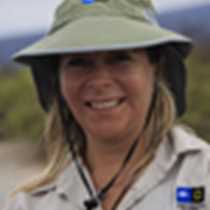Bartolomé & Santiago Islands
An optional early morning wake up call invited us to climb to the summit of the eroded crater of Bartolomé Island. We hiked up on a wooden boardwalk that was constructed on the trail by the Galápagos National Park Service to avoid erosion of this fragile area. When we reached the summit, after climbing three hundred and seventy three stairs, we enjoyed a spectacular view of the whole archipelago. Below us we admired pinnacle rock on Bartolomé Island, which is an often photographed landscape in Galápagos. Once back on board, and after a well deserved breakfast, our Expedition Leader briefed us on snorkeling safety. Bartolomé is one of the most attractive snorkeling sites in the islands. We shared our time with Galápagos penguins, sea turtles, colorful fish, flounders and even an octopus.
The afternoon’s visit was a combined snorkel outing and a walk at a site called Puerto Egas. Our naturalists told us interesting stories about humans who tried to establish in this area during the 1930’s and 60’s. Ecuadorians and even some Norwegian families attempted to settle here, mostly to mine salt from a coastal crater where salt water seepage makes this easy, but without a source of drinking water or a good agricultural area, this was impossible to accomplish. Now Santiago Island is protected, but unfortunately because of the introduced animals that people brought and released, the once plentiful land iguana of Santiago is extinct.
We followed an inland trail and then turned back on a loop along the coast. In an area of sea water filled grottos we saw the endemic Galápagos fur seals, a species of sea lion that was hunted almost to extinction during the seventeenth and eighteenth centuries. Now these Pinnipeds are protected and we have a population of several thousands of them. The tide was very low this afternoon and we had a great show of intertidal activity! Many species of birds and animals were taking advantage of the exposed algae and invertebrates. Shore birds, marine iguanas, hundreds of Sally Lightfoot crabs, Galápagos sea lions and even finches and yellow warblers could be observed around the tidal pools.
At the very end of the trail we observed the most touching scene that can be imagined. A mother sea lion coming back from a feeding bout in the sea, was greeted by her tiny young pup; they called to each other and finally touched, nose to nose, as if they were kissing hello. Immediately the hungry baby greedily started to nurse. As we boarded the Zodiacs and motored to the ship, a spectacular sunset bid us farewell. This was definitely a marvelous and full first day in this unique paradise.
An optional early morning wake up call invited us to climb to the summit of the eroded crater of Bartolomé Island. We hiked up on a wooden boardwalk that was constructed on the trail by the Galápagos National Park Service to avoid erosion of this fragile area. When we reached the summit, after climbing three hundred and seventy three stairs, we enjoyed a spectacular view of the whole archipelago. Below us we admired pinnacle rock on Bartolomé Island, which is an often photographed landscape in Galápagos. Once back on board, and after a well deserved breakfast, our Expedition Leader briefed us on snorkeling safety. Bartolomé is one of the most attractive snorkeling sites in the islands. We shared our time with Galápagos penguins, sea turtles, colorful fish, flounders and even an octopus.
The afternoon’s visit was a combined snorkel outing and a walk at a site called Puerto Egas. Our naturalists told us interesting stories about humans who tried to establish in this area during the 1930’s and 60’s. Ecuadorians and even some Norwegian families attempted to settle here, mostly to mine salt from a coastal crater where salt water seepage makes this easy, but without a source of drinking water or a good agricultural area, this was impossible to accomplish. Now Santiago Island is protected, but unfortunately because of the introduced animals that people brought and released, the once plentiful land iguana of Santiago is extinct.
We followed an inland trail and then turned back on a loop along the coast. In an area of sea water filled grottos we saw the endemic Galápagos fur seals, a species of sea lion that was hunted almost to extinction during the seventeenth and eighteenth centuries. Now these Pinnipeds are protected and we have a population of several thousands of them. The tide was very low this afternoon and we had a great show of intertidal activity! Many species of birds and animals were taking advantage of the exposed algae and invertebrates. Shore birds, marine iguanas, hundreds of Sally Lightfoot crabs, Galápagos sea lions and even finches and yellow warblers could be observed around the tidal pools.
At the very end of the trail we observed the most touching scene that can be imagined. A mother sea lion coming back from a feeding bout in the sea, was greeted by her tiny young pup; they called to each other and finally touched, nose to nose, as if they were kissing hello. Immediately the hungry baby greedily started to nurse. As we boarded the Zodiacs and motored to the ship, a spectacular sunset bid us farewell. This was definitely a marvelous and full first day in this unique paradise.




